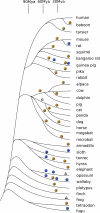Sequences from ancestral single-stranded DNA viruses in vertebrate genomes: the parvoviridae and circoviridae are more than 40 to 50 million years old
- PMID: 20861255
- PMCID: PMC2976387
- DOI: 10.1128/JVI.01789-10
Sequences from ancestral single-stranded DNA viruses in vertebrate genomes: the parvoviridae and circoviridae are more than 40 to 50 million years old
Abstract
Vertebrate genomic assemblies were analyzed for endogenous sequences related to any known viruses with single-stranded DNA genomes. Numerous high-confidence examples related to the Circoviridae and two genera in the family Parvoviridae, the parvoviruses and dependoviruses, were found and were broadly distributed among 31 of the 49 vertebrate species tested. Our analyses indicate that the ages of both virus families may exceed 40 to 50 million years. Shared features of the replication strategies of these viruses may explain the high incidence of the integrations.
Figures



References
-
- Berns, K., and C. R. Parrish. 2007. Parvoviridae, p. 2437-2478. In D. M. Knipe and P. M. Howley (ed.), Fields virology. Lippincott Williams & Wilkins, Philadelphia, PA.
-
- de Smith, M. H., and M. H. M. Noteborn. 2009. Apoptosis-inducing proteins in chicken anemia virus and TT virus. In E.-M. de Villiers and H. zur Hausen (ed.), TT viruses: the still elusive human pathogens. Springer-Verlag, Berlin, Germany. - PubMed
Publication types
MeSH terms
Grants and funding
LinkOut - more resources
Full Text Sources

